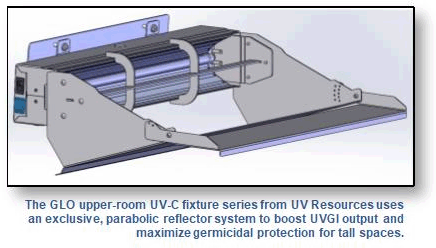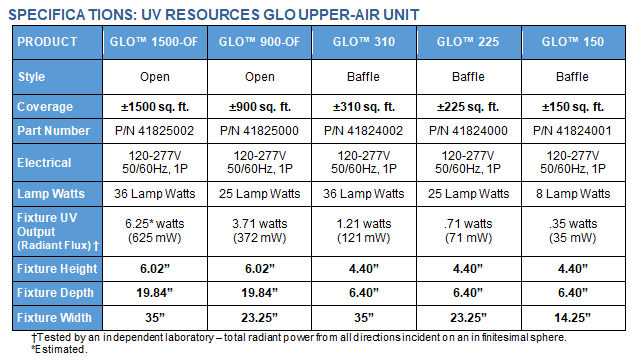|
HIGHEST UV OUTPUT
Both types of GLO fixtures—Open and Louvered—offer
excellent infection control capabilities by boosting
UVGI output via an exclusive, computer-designed, high
spectral, parabolic, aluminum reflector system that
significantly reduces internal UV energy losses.
The open design of the GLO upper-room UV-C luminaries
allows for a wide field of UVGI far above occupants’
heads. This makes the unit highly effective inactivating
pathogens in the upper-air space.
The new open fixture can be easily installed anywhere to
inactivate airborne viruses, bacteria, and mold spores.
It is designed to mitigate the risk of nosocomial
infections in locations with high ceilings, including
high-bay warehouses, cafeterias, gyms, multipurpose
rooms, museums, and other similar building types.
According to the manufacturer, the new GLO upper-air UV
Fixture exceeds the performance guidelines established
by the U.S. Department of Health and Human Services and
the Centers for Disease Control and Prevention (CDC) for
hospital and healthcare applications. The GLO open
fixture is pending ETL approval and offers a three-year
fixture and one-year lamp warranty.
HOW IT WORKS
Upper-room UV-C systems (also known as upper-air) have
been used to control airborne infectious diseases in
high-traffic areas and where people congregate since the
1940s. Upper-room UV-C fixtures utilize the natural
rise-and-fall of convection or mechanical air currents
to lift airborne infectious agents overhead, where they
are exposed to UV-C irradiation and inactivated.
Airborne droplets containing infectious agents can
remain in room air for at least three hours1. Operating
24/7/365, UV-C and upper-room germicidal is a
well-established technology that has proven effective as
a public health intervention to prevent the spread of
airborne diseases.2,3

PRODUCT SUMMARY
The GLO™ upper-room UV-C disinfection fixture series
from UV Resources now includes two new open-style
luminaries designed to irradiate air in occupied spaces
with high ceilings. (12-feet and taller). The
high-output germicidal energy disrupts microbial RNA and
DNA to prevent airborne pathogens from replicating and
spreading infection. The GLO series offers affordable
treatment solutions for spaces ranging from 150- to
1,500-square feet. Fixtures have been independently
tested for safety and UV output. For more information,
call 877.884.4822, or visit
UVResources.com.
ABOUT UV RESOURCES
UV Resources helps facility managers disinfect
moving airstreams, interrupt the transmission of
airborne infectious diseases, and kill microbial
contaminants that impede HVAC efficiency. The founders
of UV Resources pioneered the application of UV-C energy
in HVAC equipment nearly 25 years ago. Today, the
company operates a comprehensive manufacturing and
distribution network to supply market-leading UV-C
solutions worldwide. For more information, call
877.884.4822, or visit
UVResources.com.
# # #
1 Van
Doremalen, N., Bushmaker, T., Morris, D. H., Holbrook,
M. G., Gamble, A., Williamson, B. N., ... & Munster, V.
J. (2020). Aerosol and surface stability of SARS-CoV-2
as compared with SARS-CoV-1. New England journal of
medicine, 382(16), 1564-1567. Retrieved from https://www.nejm.org/doi/full/10.1056/nejmc2004973
2 Nardell & Nathavitharana (2019) Nardell E,
Nathavitharana R. Air disinfection in measles
transmission hotspots. Lancet.
2019;394(10203):1009–1010. Retrieved from https://pubmed.ncbi.nlm.nih.gov/31495498/
3 Mphaphlele et al. (2015) Mphaphlele M, Dharmadhikari
AS, Jensen PA, Rudnick SN, Van Reenen TH, Pagano MA,
Leuschner W, Sears TA, Milonova SP, Van der Walt M.
Institutional tuberculosis transmission. controlled
trial of upper room ultraviolet air disinfection: a
basis for new dosing guidelines. American Journal of
Respiratory and Critical Care Medicine.
2015;192(4):477–484. Retrieved from https://www.ncbi.nlm.nih.gov/pmc/articles/PMC4595666/ |
